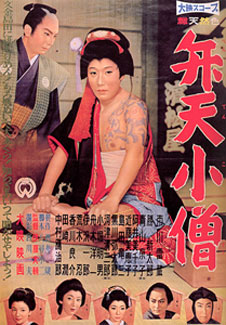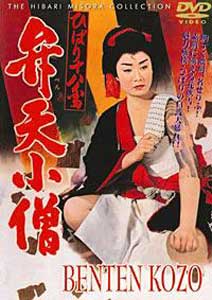 In Benten kozo (Hibari ohako Benten kozo, Toei, 1960) Hibari Misora co-stars with Kotaro Satomi, Tomisaburo Wakayama, & Cheizo Kataoka, an impressive superb cast. Benten is the Goddess of Mercy who bares a sword for dragon-slaying, & Kozo means Kid or Boy, so the title literally means "Goddess Boy." In Benten kozo (Hibari ohako Benten kozo, Toei, 1960) Hibari Misora co-stars with Kotaro Satomi, Tomisaburo Wakayama, & Cheizo Kataoka, an impressive superb cast. Benten is the Goddess of Mercy who bares a sword for dragon-slaying, & Kozo means Kid or Boy, so the title literally means "Goddess Boy."
She is cast as a combination wakashu (young man, frequently implying homosexual youth) & onnagata (female impersonator) named Kikunosuke, Kiku for short. Kiku is capable of going back & forth between genders, in one moment speaking like a highborn young lady, in the next like a street ruffian, with tattooed shoulders to prove his street credentials.
Orphaned Kiku was raised at a Buddhist temple & learned theatrical arts & martial arts as a child, which were used to put on stage productions to raise money for the temple, but also to display young lads who were essentially for sale to the highest bidder. As the film opens, Kiku is on a stage performing a Noh "red lion" dance, & a potential customer is at that moment sending money over to the priest's seating.
He is falsely accused of murdering Lady Okugata, to whom he was being pimped by a vile priest at the corrupt temple, a priest who took in orphans then when they're about to come of age sells them to the temple's wealthiest donors.
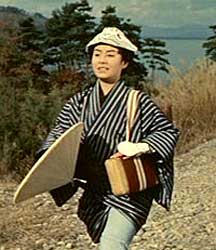 Now a young teenager, it was time to make some real money off Kiku, but he balked at being forced to sleep with "the old lady with too much make-up." When the wealthy matron is killed, the angry priest automatically blames rebellious Kiku. Now a young teenager, it was time to make some real money off Kiku, but he balked at being forced to sleep with "the old lady with too much make-up." When the wealthy matron is killed, the angry priest automatically blames rebellious Kiku.
Fleeing for his life & liberty, at first Kiku seeks out his mother Ofuji, whom he has always dreamed of meeting. At first she's friendly enough, but when she finds out there's a price on his head, she's eager to turn him in for the money. She's really a very rotten person who doesn't care one whit about her son.
Struggling against bitterness, Kiku goes underground as the thief Benten the Kid, in order to fight villainous gang members, finding a home among young heroic outlaws.
There's a gangsterish scam in the works, orchestrated by a cloth merchant, a minor official, & the crooked priest Gensho, Kiku's nemisis. They are cornering the market on salt so as to raise the price to such heights that peasants will no longer be able to afford it.
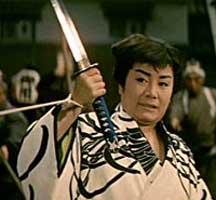 The band of robin hoods to which Kiku has become attached call themselves the Shiranami Five Alliance, & they break into the storage houses of rich merchants & distribute their gleanings among the poor. The band of robin hoods to which Kiku has become attached call themselves the Shiranami Five Alliance, & they break into the storage houses of rich merchants & distribute their gleanings among the poor.
The famous shoulder-revealing scene when the maidenly Kiku reveals he's the street-tough Benten is shown on the limited pressing DVD box reproduced here, together with two stills from the film, one showing Hibari in a huge red kabuki wig, the other showing her in high male drag as Benten the Kid.
The picture on the box curiously comes from the film's trailer rather than the film itself, with Kiku wearing a different costume & seated beside a fellow thief played by Wakayama. It's a marvelous sequence & the revelation of the shoulder tattoo, as begun on the kabuki stage, was to become a staple of yakuza films, including those of The Red Peony Gambler who took a Benten Kozo posture, dropped her kimono from her shoulder, & anounced herself as the "Oryu known as the Red Peony" as warning or as prelude to action.
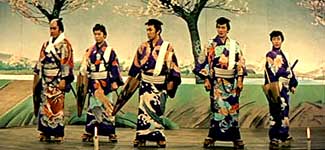 Similar to the climaxes of her Edo Girl Detective Series in which Hibari is interupted during stage performances by villains eager for a "real" swordfight, at the end of Benten Kozo, the Shiranami Five Alliance are on stage performing the introductory sequence to (what else) the kabuki play about Kiku the Kid. Similar to the climaxes of her Edo Girl Detective Series in which Hibari is interupted during stage performances by villains eager for a "real" swordfight, at the end of Benten Kozo, the Shiranami Five Alliance are on stage performing the introductory sequence to (what else) the kabuki play about Kiku the Kid.
The characters take turns giving impressive kubuki-exaggerated speeches about their lives, then the bad guys arrive in force for a big final fight sequence that begins on the stage itself, then roles out into the street.
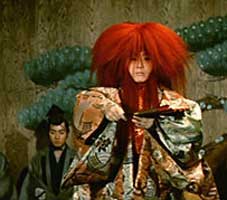 It's actually a set of five separately choreographed battles as the thieves of the Alliance scatter through the streets of Edo. It's actually a set of five separately choreographed battles as the thieves of the Alliance scatter through the streets of Edo.
We see Tomisaburo Wakayama pursued over tiled rooftops putting on a wonderful display of swordskills; Kiku has his fight elsewhere; the yojimbo-thief Rohei (Kotaro Satomi) has his battle on another st reet; & so on. It's pretty equally divided in terms of screen time, & any one of these fight scenes could've been a climax in itself.
The wonderfully twisted nature of Hibari playing a young man who pretends to be a young woman only to reveal himself as a young man is just too delicious, & the Japanese public was eating this sort of thing up in the 1950s & early 1960s.
Best known as a singer, Hibari sings two enka folksongs in Benten Kozo one near the beginning while strolling the high road to Edo, the other at the end while rowing a boat to freedom away from Edo. But by & large this is not a "singing samurai" musical but a straightforward kyokaku "town night" adventure tale.
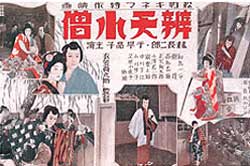 I've a lengthier discussion o Hibari-san's Gender Bending Roles, as she appeared in many films of this sort. Her version of the story of Benton Kozo is doubly interesting in the gender-bending categoriy because the role was originally for a male actor of the kabuki stage, adapted for male actors of the cinema. I've a lengthier discussion o Hibari-san's Gender Bending Roles, as she appeared in many films of this sort. Her version of the story of Benton Kozo is doubly interesting in the gender-bending categoriy because the role was originally for a male actor of the kabuki stage, adapted for male actors of the cinema.
Originally a classical kabuki play Shiranami gonin otoko (1862) by Kawatake Mokuami (1816-1893), it was later retitled after the character most loved by the public. Kawatake wrote it for a teenage kabuki player, Onoe Kikunosuke, whose name has been passed down within the kabuki community to represent a leading (specialist in female roles) in each generation.
Right from the first time the play was performed it was already pulling a gender-double-whammy in the kabuki-za, by being a male actor of female roles playing a man pretending to be a woman.
Benten Kozo was first filmed by Teinosuke Kinugasa in a 1928 silent film, with Kazuo Hasegawa in the title role, an actor who had trained as an onnagata before going into films. Not many Japanese silent films have survived for a combination of reasons, but this one does survive.
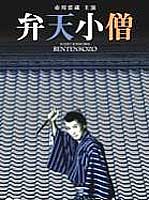 Another version of Benten Kozo (The Gay Masquerade, Daiei, 1958) has had a limited pressing DVD. This widescreen color version starred Raizo Ichikawa as the intergendered hero, Benten the Kid, who with a band of thieves wage a campaign against the oppressive Lord Koinuma, while in his/her parallel life lives as a woman. Another version of Benten Kozo (The Gay Masquerade, Daiei, 1958) has had a limited pressing DVD. This widescreen color version starred Raizo Ichikawa as the intergendered hero, Benten the Kid, who with a band of thieves wage a campaign against the oppressive Lord Koinuma, while in his/her parallel life lives as a woman.
It co-stars Shintaro Katsu as Toyama Saemonnojo. Also featured are Kyoko Aoyama, Michiko Ai, Yotaro Kurokawa & Mieko Kondo under the direction of that great filmmaker Daisuke Ito (author also of the gender-bender tale of Yukinojo henge (An Actor's Revenge, 1963). Akira Kurosawa's cinematographer Kazuo Miyagawa took the Blue Ribbon Award for his contribution.
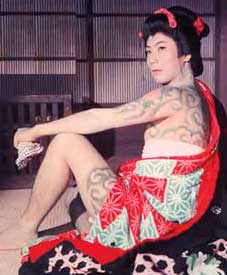 Illustrations from two DVD releases of Raizo's version of Benten Kozo are shown here, one showing the most famously thrilling scene with him/her revealing his/her tattooed shoulder. Illustrations from two DVD releases of Raizo's version of Benten Kozo are shown here, one showing the most famously thrilling scene with him/her revealing his/her tattooed shoulder.
Such gender-bent performances are inherited from the kabuki theater, which began as an all-women's theater at the beginning of the Tokugawa period, with women sexily playing male roles, displaying their charms to attract patrons or customers. This was the onna-kabuki founded by a renegade Shinto nun named Okuni, who in fact specialized in male roles.
Her perverse theater was so popular that she soon permitted wakashu into her troupe specifically to play women's roles. The samurai class was hugely fascinated by this theater, as they were already primed by a system of "comrade love" to have bisexual proclivities as their natural norm. But comrade love was supposed to increase soldiers' strength & devotion, whereas wakashu-kabuki & onna-kabuki pretty much served as advertisements for prostitution.
So the Tokugawa government eventually outlawed onna-kabuki altogether & mandated that the youths of the wakashu-kabuki shave their forelocks so that they could not so easily pass for women. The young onnagata actors obeyed the law under threat of severe punishment but they wore bandanas around their foreheads which became a fashion craze among women, as the fashion world of the time came to be dictated by what was seen in the theaters.
Periodically throughout the Tokugawa period the government cracked down on samurai desire for the gender-bent actors, but even as that last gasp of medievalism was fading & the Meiji Restoration was on the horizon, playwrights continued to write sexy plays for beautiful young men who could play either sex. Indeed, the original play that was adapted to films as Benten Kozo was written in 1962 for the ambiguous teenage actor Onoe Kikunosuke V, whose name continues to be inherited in the modern kabuki theater by young onnagata performers.
copyright © by Paghat the Ratgirl
|

